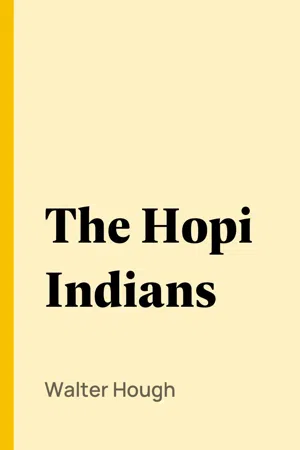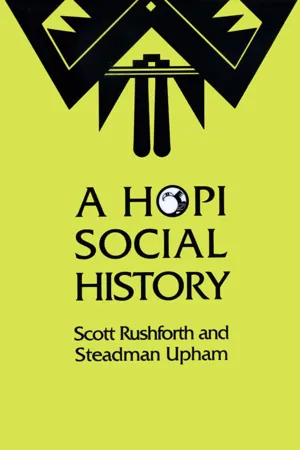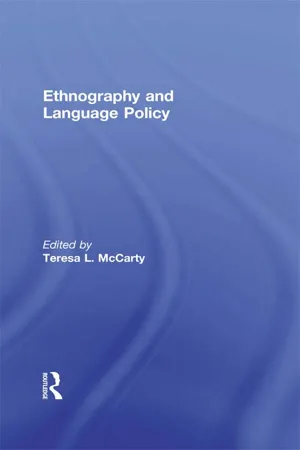History
Hopi Tribe
The Hopi Tribe is a Native American tribe located in northeastern Arizona. They are known for their rich cultural heritage, particularly their intricate artwork, traditional dances, and unique agricultural practices. The Hopi are also recognized for their strong spiritual beliefs, which are deeply rooted in their connection to the land and their reverence for nature.
Written by Perlego with AI-assistance
Related key terms
3 Key excerpts on "Hopi Tribe"
- eBook - ePub
- Walter Hough(Author)
- 2018(Publication Date)
- Perlego(Publisher)
THE HOPI INDIANS
By WALTER HOUGH Curator Division of Ethnology, United States National Museum, Washington, D. C.Publisher's device CEDAR RAPIDS, IOWA THE TORCH PRESS, 1915Copyright 1915 By The Torch Press AprilLITTLE HISTORIES OF NORTH AMERICAN INDIANS ———— Number FourIN THE SAME SERIESTHE NAVAHO By Oscar H. Lipps Supervisor in Charge, U. S. Indian School, Carlisle, Penn. With map and illustration in three colorsTHE IOWA By William Harvey Miner With map and illustrations in halftoneTHE INDIANS OF GREATER NEW YORK By Alanson Skinner Assistant Curator of Anthropology, American Museum of Natural History, New York With a map of the regionEach Volume 12mo, $1.00 net Delivery extraA Hopi woman and child sit in a doorwayTo My WifePhoto by P. G. GatesA MADONNA AMONG THE MOKIPassage contains an image
CONTENTS
The Country, Towns, and Peoples 13 Social Life 28 Food and Rearing 49 The Workers 69 Amusements 102 Birth, Marriage, and Death 114 Religious Life 132 Myths 179 Traditions and History 201 Brief Biographies 218 The Ancient People 250 Index 263 Passage contains an image
MESA FOLK OF HOPILANDPREFACE
Whoever visits the Hopi falls perforce under the magic influence of their life and personality. If anyone entertains the belief that “a good Indian is a dead Indian,” let him travel to the heart of the Southwest and dispel his illusions in the presence of the sturdy, self-supporting, self-respecting citizens of the pueblos. Many sojourns in a region whose fascinations are second to no other, experiences that were happy and associations with a people who interest all coming in contact with them combined to indite the following pages. If the writer may seem biased in favor of the “Quaker Indians,” as Lummis calls them, be it known that he is moved by affection not less than by respect for the Hopi and moreover believes that his commendations are worthily bestowed. - eBook - ePub
- Scott Rushforth, Steadman Upham(Authors)
- 2014(Publication Date)
- University of Texas Press(Publisher)
katchinas themselves) may have had some effect on Hopi religious ideology not reflected in the historical or ethnographic literature. Further, we see no reason to suggest that the Hopi ceremonial cycle was fundamentally altered in the years under consideration. Hopi religious societies probably continued to perform both public and private rituals based on mythologically expressed beliefs about the universe, with the intention of increasing community well-being and agricultural plenty. This sacred/secular dichotomy was the primary point of contention between Spanish priests and Hopi political leaders, who were priests themselves. The Pueblo Revolt of 1682 and the destruction of Awatovi during the fall of 1700 or winter of 1701 were largely about this issue. As indicated earlier, part of the Hopi motivation for participation in the Revolt was the proven ineffectiveness of Catholicism for bringing rain and ensuring plentiful crops.On the other hand, we see no reason to assume that relationships between Hopi descent groups, ceremonies, religious societies, and political leadership were invariant during this period. We would be surprised if this were the case. Again, we see flexibility and resilience in the structural and organizational arrangements involving the above institutions and activities. We first discussed Hopi resilience when considering prehistoric Western Pueblo abandonments. We now return to this subject.Flexibility in historic Hopi sociocultural arrangements is illustrated in many ways (see Parsons 1933:21ff.; Titiev 1944; Eggan 1950; Nagata 1970; Whiteley 1988a, 1988b). The specific clans and the number of clans represented in the different Hopi villages, for example, vary. Different clans (or clan segments) control different ceremonies and occupy different leadership positions in the various Hopi pueblos. The control by one descent group of a particular ceremony might be switched to another descent group if the first becomes too small or dies out. Ceremonies might be lost entirely under similar circumstances. Village leadership might be shared or rotated among the heads of various descent groups, or change from the head of one group to the chief of another group under similar demographic conditions.11 A woman might even become kikmongwi - eBook - ePub
- Teresa L. McCarty, Teresa L. McCarty(Authors)
- 2014(Publication Date)
- Routledge(Publisher)
Supawlavi, and tell ’em my clan, then, just what Hopi is about.By using the Hopi language, Dorian conveys a distinctly Hopi cultural identity. She used her title as a public platform to promote the importance of maintaining one’s heritage language: “If you know it, speak it; use it,” she implored. She further alluded to a deeper sense of the importance of the Hopi language to express a distinctly Hopi identity: “You don’t learn it for nothing … They [parents] didn’t teach us how to introduce ourselves in Hopi for nothing.”ConclusionContemporary Hopi youth such as Dorian, Jared, and Justin convey a mature understanding that every Hopi individual is vested with a personal responsibility and obligation to maintain the substance of Hopi culture by adhering to the traditions in a personal way and from a personal sense of duty (Spicer, 1975). Although their abilities in the Hopi language differ, the language nonetheless has a home in the context of these youths’ cultural worlds – in the course of daily activities, social institutions such as naming practices and marriages, and ritual performances and ceremonies. The youths’ experiences foreground the fact that there are messages in cultural practices beyond the words associated with the culture (Dauenhauer & Dauenhauer, 1998; Hale, 1998; Jocks, 1998; King, 2001; Urban, in King, 2001). Hopi traditions continue to be practiced so that for many Hopi youth who grow up in their villages, the Hopi world is the first world they come to know in the course of living it through active participation and involvement in those traditions. This suggests that while time and contact with the outside world have brought many changes, there continue to be Hopi who remain committed to corn as a way of life; one that continues to give purpose to and guides the Hopi people toward their destiny as established at Emergence. The continuing maintenance of Hopi traditions, then, offers a strong prospect for effective and successful language planning and language policy development directed toward “maximizing the influence of a particular language” (King, 2001, p. 12).
Index pages curate the most relevant extracts from our library of academic textbooks. They’ve been created using an in-house natural language model (NLM), each adding context and meaning to key research topics.


